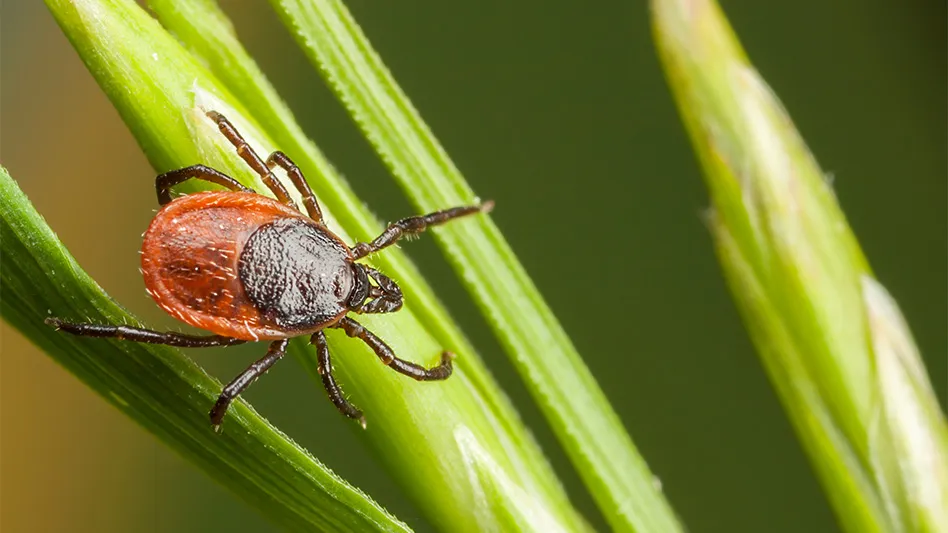Have you ever taken a challenging insect specimen to an entomologist, only to have him or her identify in seconds something you’ve labored over for an hour or more?
Training definitely plays a role in this — an entomologist has spent hundreds of hours in school practicing the identification of insect specimens. This practice builds knowledge of a handful of key traits that allows rapid identification, even when he or she isn’t familiar with a specimen.
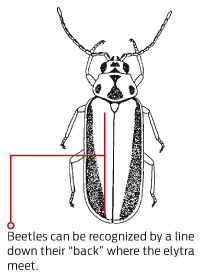 These are called rapid identification traits. They won’t necessarily allow you to figure out the species to which a specimen belongs, but they can get you partway there by figuring out the group to which it belongs. In some cases, like the unusual insects that come in from outdoors, that’s enough. In other cases, it can hone in your search when you are using a reference such as the “NPMA Field Guide,” looking it up on the Internet or attempting to identify the pest based upon where it was found.
These are called rapid identification traits. They won’t necessarily allow you to figure out the species to which a specimen belongs, but they can get you partway there by figuring out the group to which it belongs. In some cases, like the unusual insects that come in from outdoors, that’s enough. In other cases, it can hone in your search when you are using a reference such as the “NPMA Field Guide,” looking it up on the Internet or attempting to identify the pest based upon where it was found.
Sometimes all you have are a few body parts to inspect for identification. Rapid identification traits can help with this, too. You may not be able to come away with an exact identification, but you can put it into a group of insects, and sometimes that’s enough of an identification.
Line Down the Back. If you see a straight line down the back of an insect, that insect is probably a beetle. Beetles have elytra, or wing covers, that cover part of the thorax and often the entire abdomen. Unless the beetle is flying, the elytra will be flat against the back of the beetle, where they meet in a straight line.
We encounter many beetle pests in our industry: stored product pests, fabric and carcass pests, wood-destroying insects, mold and moisture pests and so on. There are a lot of beetles that aren’t pests, too; they are simply insects that live outdoors with little interest in coming inside.
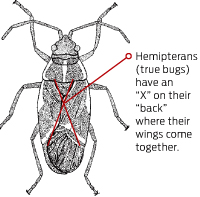 “X” Marks the Spot. If you see an “X” pattern on an insect’s back, you are most likely dealing with a group of insects called Hemiptera. The X is formed by the way its wings fold together.
“X” Marks the Spot. If you see an “X” pattern on an insect’s back, you are most likely dealing with a group of insects called Hemiptera. The X is formed by the way its wings fold together.
I don’t like using technical, scientific names unless I have to, and this is a time when the scientific name is useful to the PMP. The common name for the Hemiptera is “bug.” Some people prefer to say “true bug” to be clear that they are talking about a Hemipteran as opposed to any insect. But, is that really any more clear?
Many pests we deal with that have “bug” in their names belong to Hemiptera: box elder bugs, stink bugs and bed bugs. (Since the bed bug, thankfully, doesn’t have wings, it doesn’t have an X on its back.) Some pests we deal with that have “bug” in their names aren’t part of Hemiptera. You can tell if they aren’t, because the “bug” in their names will be part of another word in their names, such as ladybug (a beetle) or potatobug (a sowbug or type of cricket, depending upon where you live).
There are not many pests in Hemiptera with which we deal. If you have someone bring in a Hemipteran and it’s not one that you know, it’s likely one of the many species that live outdoors on plants. Most of these can be grouped together as plant bugs.
Here’s one more trait for Hemiptera: If you find one with which you aren’t familiar and it’s all black, it’s probably an assassin bug. Not all assassin bugs are black, but many of those that are brought to me are. Assassin bugs are normally just occasional invaders, although they will inflict a painful bite if disturbed.
Wasp Waist and Node. The classic wasp waist is a misleading name, making you think that it only applies to wasps, when it actually applies to wasps, hornets, bees and ants. If you find a specimen with a wasp waist, you know you have something in this group of insects, but saying “wasp, hornet, bee or ant” is a mouthful, so we’re going with another scientific name: Hymenoptera.
People often get confused trying to tell apart small wasps and ant swarmers — or winged ants. Fortunately, there’s an easy way to tell. Look at the wasp waist and see if you can find a node. Ant swarmers will have one or two nodes and wasps will not.
This also applies to specimens without wings. In some parts of the country, you can find velvet ants. If you look closely, you’ll see that they don’t have a node. Velvet ants are actually wingless wasps. Be careful if you find one — they pack a nasty sting!

The Two-Wingers. Counting wings on insects can help with identification. The vast majority of insects have four wings. Beetles don’t — but you rarely see their wings to count them, since they are hidden under the elytra.
The majority of two-winged insects that you find will be flies. Their scientific name even reflects this: Diptera. “Di” means two, like in dichotomy or two choices. “Ptera” means wings, like in pterodactyl, the winged dinosaur.
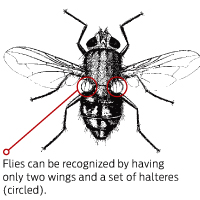 Flies also look like they have a little stick with a knob on the end coming out of their bodies on either side behind the wings. These are called halteres and they spin during flight like gyroscopes on a jet fighter.
Flies also look like they have a little stick with a knob on the end coming out of their bodies on either side behind the wings. These are called halteres and they spin during flight like gyroscopes on a jet fighter.
Just as with the common name for the Hemipterans, you can tell if something is a fly based upon how its name is written. The house fly, deer fly and march fly all have their names written as two words. These are flies. The mayfly, dobsonfly and caddisfly are not.
Many flies are related to decay, filth or carcasses. Others, such as mosquitoes and black flies, are blood feeders. Yet others breed in marshy areas, like lake flies and midges. Flies are one of the largest groups of insects, with an equally large amount of diversity.
If you get a fly that you can’t identify, try to match it up with decay, blood-feeding or occasional invader flies. If those don’t pan out, then chances are you’ve run across one of the innumerable other types of flies.
Final Thoughts. It isn’t necessary to figure out the exact species of every insect specimen you encounter. If it is an individual sample and doesn’t appear to be a pest, rapid identification traits can allow you to give it a name, rather than just telling your client that it’s some type of “bug.” (And now you won’t look at that name the same, either, will you?)
Also, if you have a damaged specimen, rapid identification traits will let you hone further in on its identity, perhaps even allowing you to figure out what it is based upon the traits you see and where it was found.
The author is a Board Certified Entomologist and training and technical services manager at Batzner Services, New Berlin, Wis. E-mail him at tsnyder@giemedia.com.
Terminology Review
Hemiptera
The “true bugs,” including box elder bugs, stink bugs, bed bugs, assassin bugs and a variety of plant bugs.
Hymenoptera
Wasps, hornets, bees and ants.
Diptera
“Two wingers” or flies.
Elytra
The wing covers on the back of a beetle, which meet in a straight line.
Halteres
Two little sticks with knobs on the ends, found behind the single set of wings on flies.
Node
A single or double bump (one node or two node) found in the wasp waist of ants, but not in other Hymenoptera.
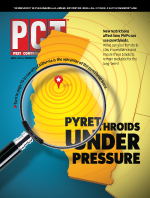
Explore the April 2012 Issue
Check out more from this issue and find you next story to read.
Latest from Pest Control Technology
- Ground Control
- Scientists, PMPs Collaborating to Map Termite Distribution in Southern U.S.
- Viking Pest Control Organizes a Charity Bike Build for Local Families
- Gaining Control of Structure-Infesting Carpenter Ants
- Big Blue Bug’s Brian Goldman Receives Rhode Island Small Business Person of the Year Award
- UF Researchers Examine How Much Bait it Takes to Eliminate a Subterranean Termite Colony
- Women in Pest Control Group Continues to Grow, Provide Opportunities in the Industry
- NPMA Announces Results of 2024-2025 Board of Directors Election


